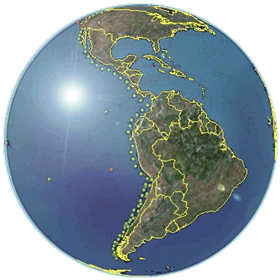
Hindcast
HINDCAST The deepwater wave database covering the period from 1985 to 2005 was developed with a state-of-the-art 3rd generation wave hindcast model, WaveWatch III of the U.S. National Oceanic and Atmospheric Administration (NOAA).
The WaveWatch III spectral ocean wave model is particularly skilled in the prediction of long-distant swells due to the advanced numerics incorporated in the propagation algorithm.
The modeling program which produced the database provides improvements in a number of areas:
- Significantly improved wind fields through statistical correction by means of scatterometer ocean wind measurements from the QuikSCAT satellite.
- Comprehensive validation against multi-year satellite altimeter data over the entire Pacific Ocean.
- New types of wave output products. .
Key distinctions of this hindcast as compared to other hindcast wave data available for the region are:
 Statistical Consistency :
Statistical Consistency :
In many other hindcasts, particularly those based on use of atmospheric forecasting products, the details of the modeling (for example, the model resolution), vary throughout the duration of the hindcast, resulting in a variation in statistical errors in time. Baird's Pacific Ocean hindcast is based on the use of statistically consistent wind fields.
No wave data assimilation into the hindcast :
Many hindcasts apply local "corrections" to the hindcast data through assimilation of measured wave data. This assimilation limits the ability to independently verify the results of the hindcast.
Spectral data availability :
Complete frequency-direction spectral data are available along the entire Pacific coastline. Given the bi-modal complex wave condition along the Pacific shorelines of north, central and south America, any site shoulde analyzed using full spectral data.
A full set of integrated wave parameters are derived from the directional wave spectra, including the distinction of up to six different sea/swell components in a specialized times series file.
Model outputs include:
- Gridded fields of mean wave parameters (Hs,Tm, MWD, directional spread, peak frequency, peak direction,peak frequency of seas, mean direction of seas) on a 6-hourly basis.
- Directional wave spectra on a 3-hourly basis every 2 degrees of latitude along the entire Northern and Southern American coastline.
- Directional wave spectra on a 3-hourly basis at various wave buoys and satellite altimeter validation locations.
Home | Hindcast | Wind Field Generation | Validation | Acquiring Wave Data | Contact us, downloads, links
A joint project by the Hydrographic and Oceanographic Service of Chile (SHOA) and Baird & Associates Coastal Engineers Ltd.